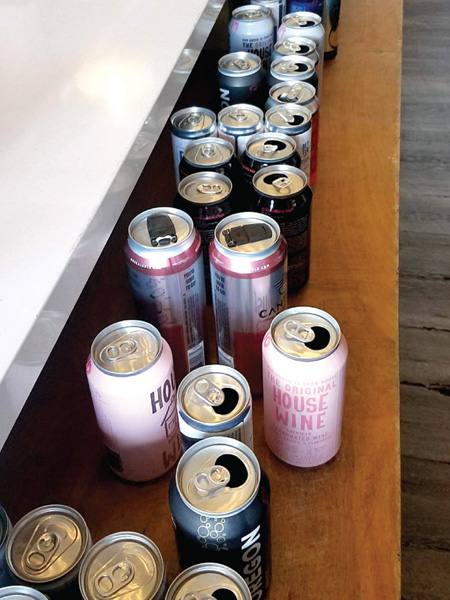As canned wines gain momentum, everyone from natty wine producers to Trader Joe’s is getting in on the game. But, as our recent tasting made clear, packaging wine in a can presents a different set of challenges than bottling it.
Like other canners, Faith Armstrong of Onward and Farmstrong Wines has worked to find the right level of sulfur on the canning line. She thinks some of the original issues with wine in cans had to do with sulfur levels that were more appropriate to cork-finished bottles. So, she did some tests and found that it was important to include some sulfur, but at lower levels. “With cork, you are going to have some transfer of oxygen across that cork,” she points out, “and people use sulfur to promote freshness as the wine ages. With a can, there is absolutely no transfer of anything. It’s a fully sealed vessel. There’s no oxygen getting in; there’s nothing getting in or out of that can.” So, too much sulfur can create reductive compounds, which lend the wines off odors.
Thomas Pastuszak, who leads the wine program at NYC’s NoMad, recalls his first experiences with canning wine when he set out to produce Vinny, his sparkling wine in cans. “I realized that to make a wine that is balanced once it is effervescent, the wine itself would need to be a little bit more generous, so when you carbonate, it does not become too shrill or thin. When you add carbonation, it basically thins out the wine. You get the benefit of the crispness and the freshness, but you need to have a little bit more stuffing in the wine to begin with. So, that was one really important learning curve.” He also chose a 250-millimeter can that would hold the pressure he hoped to sustain in the wine.
Even in still wines, there’s a challenge in getting the right pressure on the can wall, as Jake Stover of Sans Wine in Napa Valley pointed out: “It’s really important to get the liquid nitrogen dosing right, to force out any oxygen,” which helps to avoid “squishy” cans.
THE RED WINE CONUNDRUM
In our small sample set, the sparkling wines, whites and rosés were far more successful in cans than still reds. When questioned about this, several producers noted that people are used to drinking cold, carbonated beverages, not red wine, out of cans.
But we tasted out of glasses, at room temperature. Our findings weren’t based on an intrinsic bias; they were based on our reactions to the wines in the glass.
Josh Schaffner works with Ninth Planet Beverage Solutions, a mobile canning line that got its start with the craft beer movement and has expanded to canning wine. They use Ball products, the industry standard (and the same Ball that produces canning jars). He told me that while the lining of the can is proprietary, Ball requires that all wines be tested for their interaction with that liner. “It’s called corrosivity testing,” he said. “It takes about three weeks, and they performed this test free of charge.”


Still, according to Schaffner, “The corrosivity test is what tells you whether or not the can lining can withstand the beverage in the can and for how long, and [some] red wines are much more aggressive than [most] whites are.” So, even if a red wine passes the corrosivity test, it still may be reacting with the lining of the can. In other words, it’s best not to age red wine in a can.
We did find both fresh, chillable, unoaked reds and oak-aged styles that were successful, but the lower-pH sparklers and whites had a better batting average. If you’re looking for the convenience of wine in a can, your best best is to pop the top on some bubbles.
This story was featured in W&S June 2019.
Karen started her career in wine as an enologist at Araujo in Napa Valley, having graduated with a BA in International Relations and French from UC Davis. She went on to handle education and sales support for Indie Wineries in California before joining the sommelier team at Spago for a year. For the past several years, she has been working with the publishing group behind the Somm Journal, part of the launch team for The Clever Root, where she served as Managing Editor for two years, then going freelance as a Senior Editor, to raise her daughter, who is now two years old. She also contributes to the Josephine Porter Institute’s newsletter on Applied Biodynamics. Karen has studied in Bordeaux and worked in the Rhône, led there by a glass of Domaine du Pegau, which sparked her interest in the Rhône. And it was a bottle of Diamond Creek’s Gravelly Meadow from the early 1990s that had shifted her view of Napa Valley—her family has been in the Valley for five generations, and once had a dairy farm on the land that became Lake Berryessa.
This story appears in the print issue of June 2019.
Like what you read? Subscribe today.















